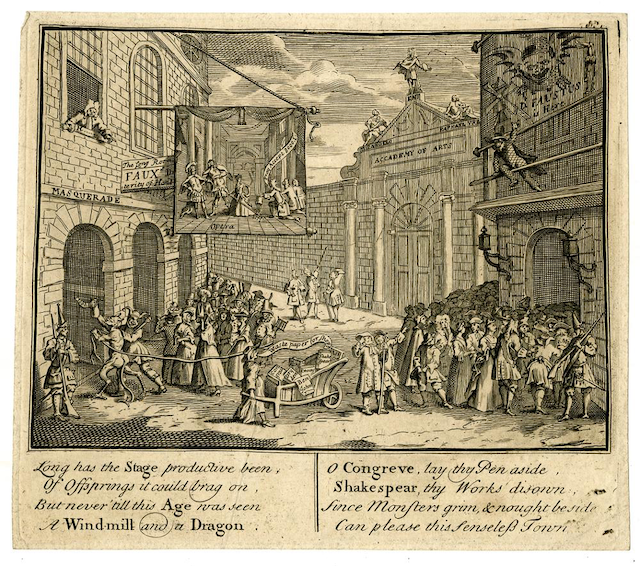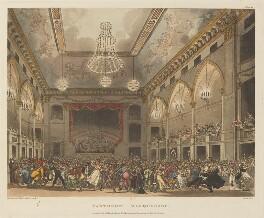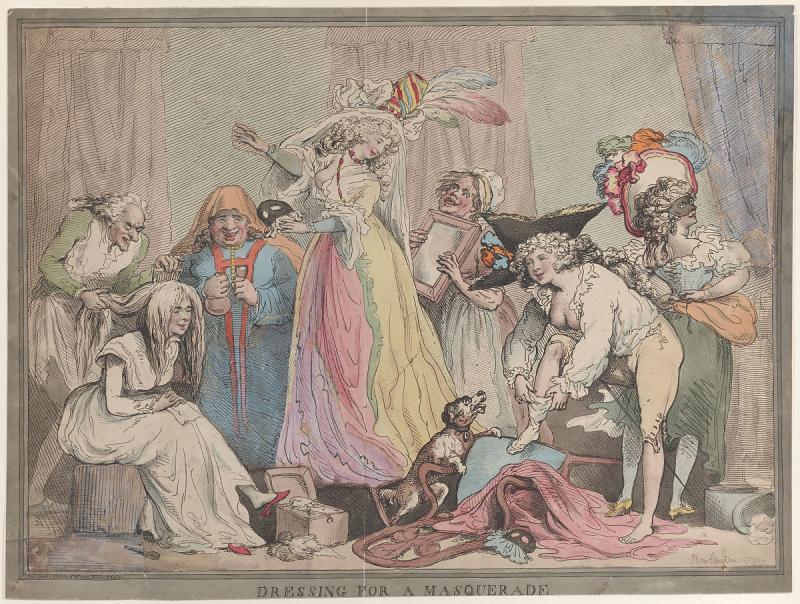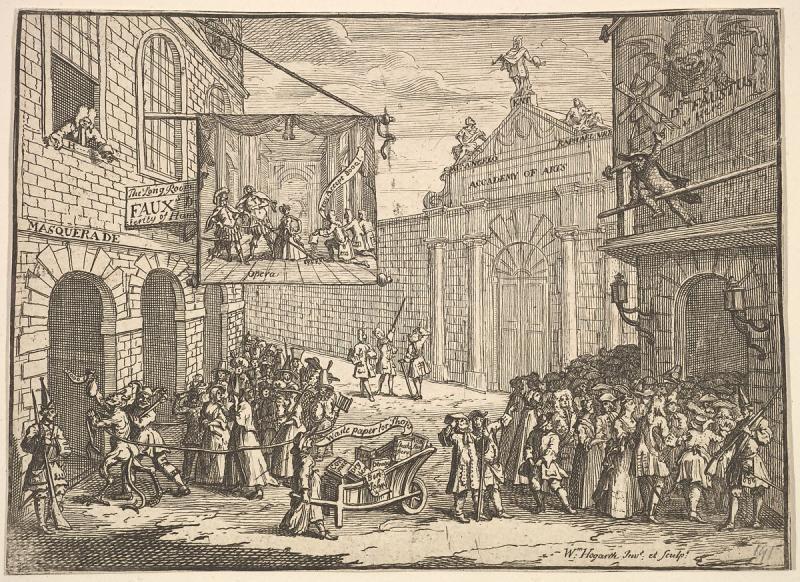Résumé
Masquerades – sociable assemblies of masked participants – developed into forms of public entertainment in eighteenth-century London, often welcoming crowds in the fashionable centres of the metropolis, such as the Haymarket Theatre, Vauxhall Gardens or Ranelagh Gardens. The practice was endowed with a democratic potential realized through a carnivalesque suspension of social hierarchies. At the same time, the masquerade phenomenon provides insight into the category of personhood that was negotiated through a sociable performance of anonymity and new ‘selves’ in the traditions of Locke and Hume.
Mots-clés
In eighteenth-century London, the masquerade as a form of sociable entertainment developed in a twofold manner: as a crowd event of the newly emerging public sphere and a selective elitist assembly, deriving from the tradition of sixteenth- and seventeenth-century court-based masked balls, even if the boundaries separating the two variants were not always clear cut. However, the level of masquerade’s democratization in the period is questionable, with Meghan Kobza recently arguing against the heterotopic, transgressive and democratized image of the masquerade promoted by eighteenth-century fiction and eighteenth-century studies in the 1980s and 1990s (most notably the work by Terry Castle).1 Nevertheless, both written and visual representations of masked assemblies of the century show that, just like musical concerts, theatrical productions and operas, they gradually entered the realm of more accessible public entertainment. Although it was considerably expensive – Kobza (170) has estimated the lowest possible cost of masquerade participation (including ticket and costume) at 10 shillings – it offered a space of carnivalesque class disorder and transgression prompted by anonymity and identity play, even if the lower orders needed more affluent patrons to guarantee entrance (as can be seen, for example, in the well-known masquerade scenes in Henry Fielding’s Tom Jones and Amelia, Samuel Richardson’s Pamela or Tobias Smollett’s Peregrine Pickle). The masquerade assembly would typically enjoy musical accompaniment, spend the night dancing or gambling and finally reach the climactic, and quasi-ritualistic, unmasking.
- 1. Meghan Kobza, ‘Dazzling or Fantastically Dull? Re-Examining the Eighteenth-Century London Masquerade’, Journal for Eighteenth-Century Studies (vol. 43, no 2, 2020), p. 161-181; Terry Castle, Masquerade and Civilization: The Carnivalesque in Eighteenth-Century English Culture and Fiction (Stanford, CA: Stanford University Press, 1986).
The rise of the masquerade thus understood is traditionally attributed to the arrival of John James Heidegger (1659-1749), a Swiss impresario, who came to England in 1708. Heidegger recognised the commercial potential of masked assemblies and transformed them into public entertainment. In 1713 Heidegger became manager of the Haymarket Opera House, and it was there that he organised his masquerades. These were subscription-based, attracted crowds of several hundred participants and enjoyed the support of the royalty. In the first half of the century, most of the events were organised in the Haymarket Theatre. Later in the century, other popular venues included Vauxhall Gardens, Ranelagh Gardens, the Pantheon and Carlisle House, which hosted masked balls organised by Theresa Cornelys (1723-97), an Italian opera singer, who had settled in London in 1759. Cornelys’s assemblies were yet more restrictive in terms of admission, with considerably higher attendance costs (Kobza 170): the closed space of her house at Soho square supported her agenda of organising elite sociability for the select few. Indeed, despite the democratic potential of the entertainment, the major masquerades of the town were not affordable for most of the public, and the carnivalesque topsy-turvydom would have been mostly characterised by a downward movement (the higher strata dressing up as the lower strata). The divide separating the selective balls from the more democratised ones is visible in a commentary by Henry Fielding, in which social hierarchies are supported by means of moralising discourse:
I cannot dismiss this Head, without mentioning a notorious Nuisance which hath lately arisen in this Town; I mean, those Balls where Men and Women of loose Reputation meet in disguised Habits. As to the Masquerade in the Hay-market, I have nothing to say; I really think it is a silly rather than vicious Entertainment: But the Case is very different with these inferior Masquerades; for these are indeed no other than the Temples of Drunkenness, Lewdness, and all Kind of Debauchery.2
As Terry Castle notes, mentions of masquerades for the lower classes were typically commented upon in a critical manner (Castle 94). For example, the Weekly Journal (April 10, 1725) relates a forceful dissolution of a gathering of 'Chamber-Maids, Cook-Maids, Foot-Men, and Apprentices' (quoted in Castle 96), while the Gentleman’s Magazine (January, 1777) gives a brief account of a masked assembly of 'the hairdressing class', during which, we are informed, the participants were crashed by the falling floor.
- 2. Henry Fielding, An Enquiry into the Causes of the Late Increase of Robbers (London: Printed for A. Millar, 1751), p. 19.
The elitist, at least in principle, masquerades can be visualised more fully thanks to a number of written and pictorial accounts, including texts published in eighteenth-century periodicals as well as graphic works by William Hogarth, Remigius Parr and Thomas Rowlandson. A detailed report on the masquerade organised by Theresa Cornelys on February 26, 1770, for instance, was published in the Gentleman’s Magazine:
It was held at Mrs Cornely’s house in Soho Square, which was illuminated in the most splendid and picturesque masquerade manner imaginable with between three and four thousand wax-lights. About one hundred musicians were dispersed in various parts. The following is the list of the principal masques. – The figure of Nobody, the Duke of Buccleugh, who after entertaining himself and his friends some time in that character, withdrew, new dressed himself, and appeared in a most elegant dress of a Hungarian Hussar. – The figure of Somebody, his companion, Colonel Fitzroy who also afterwards appeared in another character. – Cherokee Chief, Mr Meadows, a new and very striking masque. – Cyrus, Sir William Wrottesley. – A Double Man, half Miller and half Chimney-sweeper, Sir Richard Philips: this dress was so admirably contrived that it required some observation to discover which was his real front; and this not only when standing, but also when walking; Sir Richard sometimes walking with one front forwards, and sometimes the other.3
- 3. The Gentleman’s Magazine and Historical Chronicle. Volume XL (London: Printed for D. Henry, 1770), p. 98.
This report, apart from tangibly representing the indicators of luxury and glamour, draws attention to some of the masked characters who took part in the assembly. The list does not include the popular disguise types of the eighteenth-century masked ball, however. In her study of eighteenth-century masquerade costume, Aileen Ribeiro showed that the masqueraders had three basic options to choose from: the domino, which was a neutral, usually black cloak completely covering the attendee, the fancy dress, which presented the wearer as a member of one general class, such as ‘the nun’ or ‘the devil’, and the (often theatrical) character dress, for example, from commedia dell’arte or the harlequinade.4
In listing the participants, the quoted passage nods towards another crucial aspect of eighteenth-century masquerades: identity play. The names given to the disguised participants – Nobody, Somebody and A Double Man – underline the negotiable nature of the category of person, which was part of the contemporary philosophical debate on identity, most notably the works of John Locke, who wrote about the changing states of consciousness, and David Hume, for whom ‘self’ was a loose compound of fleeting impressions. An epigonic reader of Locke, Edmund Law used the masquerade patterns as a way to explain Locke’s theory, arguing that the word ‘person’ should be understood as ‘a certain guise, character, quality, i.e. being in fact a mixed mode, or relation, and not a substance […] it amounts to no more that saying, a man puts on a mask – continues to wear it for some time – puts off one mask and takes another’.5
In a phenomenological approach, Ronald L. Grimes distinguishes several modes of masking, two of which are especially relevant for the study of eighteenth-century masked balls. Masking as concretion is constituted by ‘concretizing of dynamis in a fixed form’.6 As the anthropologist explains, concretion as a mode of masking, exemplified by the character-types of commedia dell’arte, refers to characters who cannot exist without their masks. Concealment, in turn, is ‘an act of concealing identity’ inasmuch as ‘to don a mask is to don an other and doff a selfhood’ (Grimes 511). As Grimes continues (512-513), this ‘masked identity-suspension’ leads to a situation in which ‘[w]ho one is not becomes more important than who one is’. At an eighteenth-century masquerade these two modes were reconciled in a very peculiar way. Masqueraders sought identity-suspension, which was guaranteed by the masks and disguises they wore, and which lifted social and cultural restrictions they were subject to. At the same time, the roles they typically chose as substitutes for their suspended selves were selected from a range of stock masks and dresses which were then at their disposal. Suspending their identity, masquerades provided participants with new though typified selves valid only during the assembly and concretised by masks and costumes they wore. This, however, had an empowering potential. For example, even if male anti-masquerade writers typically discussed the dangers that this 'promiscuous assembly' posed to female participants (Castle 96), it could also be seen as a potential utopia of female sovereignty, which 'engendered an ‘Amazonian race'', a society of 'women unmarked by patriarchy' (Castle 255).
- 6. Ronald L. Grimes, ‘Masking: Toward a Phenomenology of Exteriorization’, Journal of the American Academy of Religion (vol. 43, 1975), p. 511.
The eighteenth-century masquerade can also be understood more broadly, even metaphorically. Janusz Ryba defines the masquerade as ‘a rather extensive sphere of human gestures and behaviours, aiming at changing one’s appearance or identity, pretending and misleading others by means of false 'creations''.7 Before offering this definition, Ryba (18) comments on selected eighteenth-century customs, such as incognito travels or the theatricality of social conventions, and argues that their common denominator was an obsession with masquerading. This more comprehensive approach towards the phenomenon brings to mind the metaphor of the world as a masquerade, which was a period-specific variant of the theatrum mundi metaphor, having emerged as a consequence of the transposition of masquerading behaviours into diverse spheres of social life. For example, in ‘An Essay on the Knowledge of the Characters of Men’, Henry Fielding wrote: 'The whole World becomes a vast Masquerade, where the greatest Part appear disguised under false Vizors and Habits; a very few only shewing their true Faces, who become, by so doing, the Astonishment and Ridicule of the rest.'8
- 7. Janusz Ryba, Maskarady oświeconych: Próba opisu zjawiska [Masquerades of the Enlightened: A Study of the Phenomenon] (Katowice: Wydawnictwo Uniwersytetu Śląskiego, 1998), p. 19, my translation.
- 8. Henry Fielding, Miscellanies, Vol. I (London: Printed for the Author and sol by A. Millar, 1743), p. 184.
Eighteenth-century masquerades almost immediately found their place in fiction. As Castle demonstrates (114-5), the modern novel and the masquerade were by nature related, as both had a democratic potential and expressed tensions between morality and transgression. Masquerade scenes appeared in much of eighteenth-century narrative fiction, most memorably perhaps in Elizabeth Haywood’s The Masqueraders and Fantomina (1724), Daniel Defoe’s Roxana (1724), Samuel Richardson’s Pamela (1741) and Sir Charles Grandison (1753), Henry Fielding’s Tom Jones (1749) and Amelia (1751), John Cleland’s Fanny Hill (1749), Tobias Smollett’s Peregrine Pickle (1751) or Frances Burney’s Evelina (1778) and Cecilia (1782). Their function was typically that of ‘plot catalysts’ (Castle 127), precipitating consequent shifts of fortune, discoveries, major social and moral reversals and transformations. At the same time, they constituted a cultural emblem of the beau monde, often framed with typical moral considerations, related to the so-called ‘anti-masquerade writing’ of the time. Thus, when in 1755 public opinion was horrified by accounts of the earthquake in Lisbon, anti-masquerade writers suggested some of the blame be put on the moral corruption caused by masquerading (Castle 84), which resulted in a momentary decrease in the entertainment’s popularity.
Best known visual criticism of masquerades includes the work of William Hogarth. In his early print, ‘Masquerades and Operas’ from 1724, sometimes referred to as ‘The Bad Taste of the Town’, Hogarth shows masqueraders and opera goers led by the devil (whose masquerading tricks were highlighted in anti-masquerade writing) to enjoy a foreign import, as opposed to inherently English culture, here represented by the works of Shakespeare, Dryden and Congreve that are going to be used as waste paper.

References to the masquerade are also skilfully included in A Harlot’s Progress and A Rake’s Progress, with the same indispensably didactic agenda. The inheritor of Hogarthian aesthetic, Thomas Rowlandson offered a satirical take on the subject, without the pretentious didacticism. Two of his prints, ‘Dressing for a Masquerade’ and ‘Pantheon masquerade’, show two sides of the sociable experience: the intimate framework of the ‘before’ and ‘after’ and the disorderly crowd sociability, respectively.
The masquerade remains at the core of popular visualisations and reconstructions of Georgian London and urban sociability, not least due to its celebrity proponents, such as Lady Mary Wortley Montagu and Horace Walpole. A complex phenomenon at the intersection of social life and discursive practices, it provides unique insight into the period’s material culture, sociable interactions, value systems and creative arts.
Partager
Références complémentaires
Craft-Fairchild, Catherine, Masquerade and Gender: Disguise and Female Identity in Eighteenth-Century Fictions by Women (University Park: The Pennsylvania State University Press, 1993).
Greig, Hannah, The Beau Monde: Fashionable Society in Georgian London (Oxford: Oxford University Press, 2013)
Munns, Jessica and Penny Richards (eds.), The Clothes That Wear Us: Essays on Dressing and Transgressing in Eighteenth-Century Culture (Newark: University of Delaware Press, 1999).
Wahrman, Dror, The Making of the Modern Self: Identity and Culture in Eighteenth-Century England (Yale: Yale University Press, 2004)


